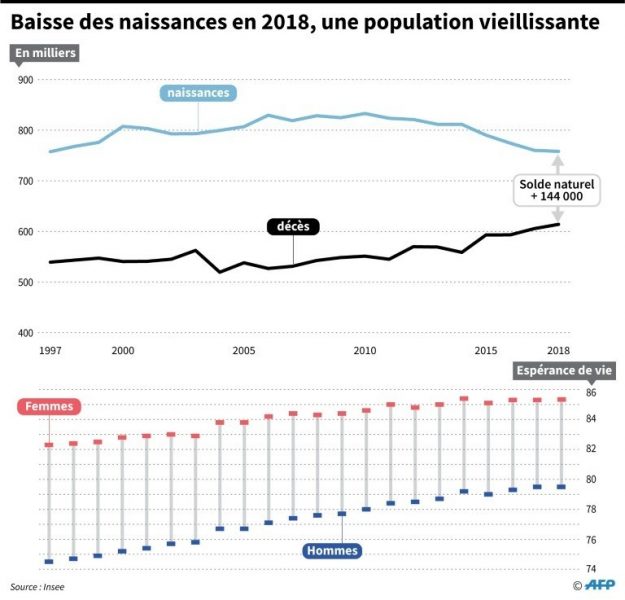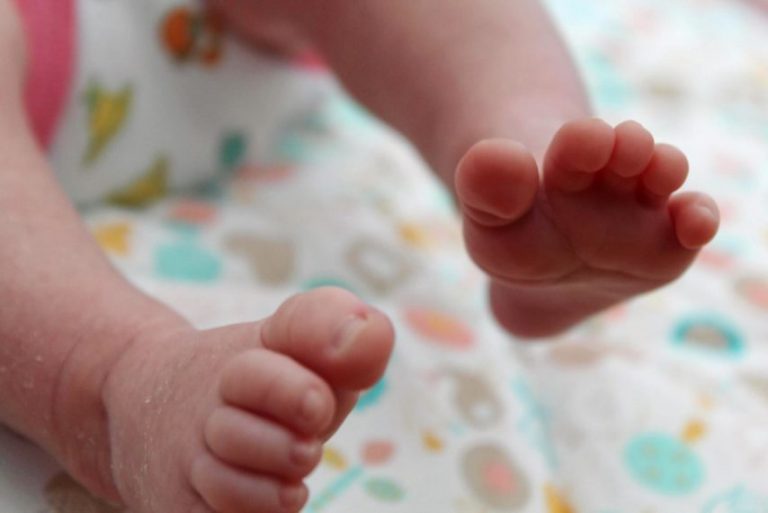According to INSEE figures, the population of France continues to grow, but at a slower pace. The gap between the number of births and deaths is narrowing
12,000 fewer babies in 2018 : fertility continues to decline in France and now stands at 1.87 children per woman , for the fourth year in a row below the symbolic threshold of 2, according to figures published Tuesday 15th January by INSEE .
The French population – 67 million on the 1st January – continues to grow, but at an ever weaker pace: + 0.3% in 2018 and 2017 after + 0.4% per year between 2014 and 2016 and + 0, 5% per year between 2008 and 2013.
The natural balance between births and deaths remains positive, but has never been so low since the Second World War. In France in 2018 there were 758,000 births (12,000 fewer than in 2017) and 614,000 deaths (8,000 more), or 144,000 more people.
The National Institute of Statistics and Economic Studies has modified its census questionnaire in 2018 to take into account “duplicates” (for example, children in shared custody declared by both parents), which results in a revised figure. for the population in 2018 of 66 891 000 people (against 67.2 million announced initially in January 2018).
As in previous years, population growth in 2018 was driven by births more than net migration , estimated at 58,000.
The drop in births seems to be slowing down: 12,000 fewer babies last year, after 14,000 fewer in 2017, 15,000 in 2016 and 20,000 in 2015. This decline is partly due to the arrival of childbearing years fewer generations than the baby boomers.
But it is especially the fertility (number of children per woman) that decreases. Women have children more and more late: 30.6 years on average at the first birth compared to 29.8 years ten years earlier.

The birth rate linked to the crisis?
“The decline in fertility first affected younger women, between 25 and 29 years, it now affects all women of childbearing age and all levels of life,” said Sylvie Le Minez, head of demographic and social studies .
Crisis and birth are they related? In the past, the birth rate has stalled several times, in 1973 during the first oil crisis, which marks the end of the baby boom for INSEE, then in 1993. It has been on the ups and downs since 2008 with a real stall for 4 years .
“Yet the French always want to have children : their desire to have children generally varies little, around 2 or 3 children,” said the National Union of Family Associations Tuesday in a statement. The Unaf denounces public policies “less favorable to families with children for years” and stresses that “the opening of the Great Debate should be an opportunity to listen to families.”
France remains the most fertile country in the European Union. In 2016, it stood at 1.92 children per woman ahead of Sweden (1.85) and Ireland (1.81).
Life expectancy at birth is 85.3 years for women and 79.4 years for men. If it progresses for men (0.2 years gained since 2014), it falls for women, who have not found that of 2014 (85.4 years).
“Is life expectancy stagnating? “Asks Sylvie Le Minez. According to her, the numbers are not yet very legible because we must take into account a particularly fatal flu episode last winter and a heat wave in July / August.
But it seems that the life expectancy of women in particular has stalled, perhaps reflecting the adoption of formerly male lifestyles (work, alcohol, tobacco).
Sign of the ageing population, one in five people in France is 65 or older, while the proportion of less than 15 years is less than 18.3%.




